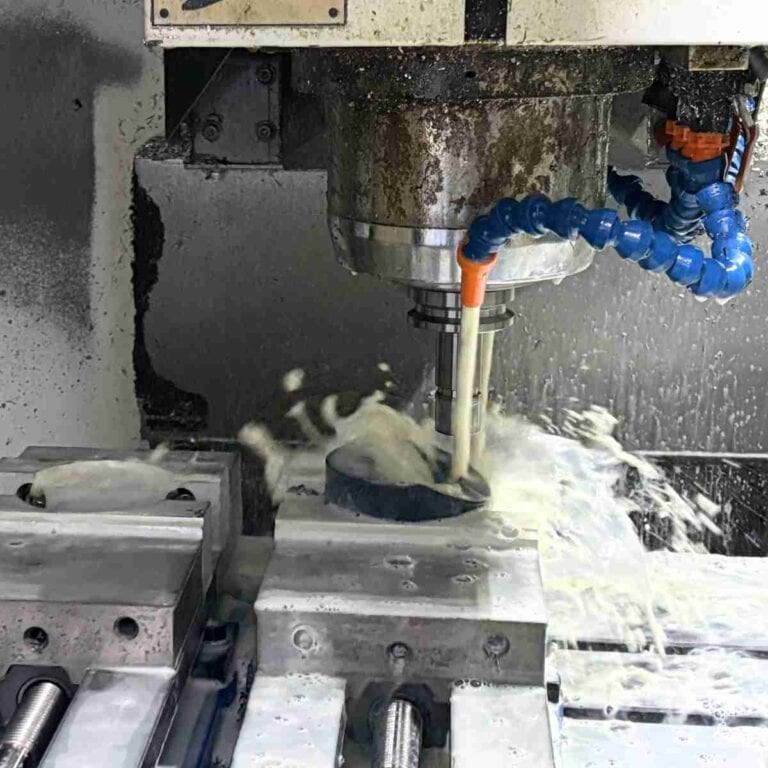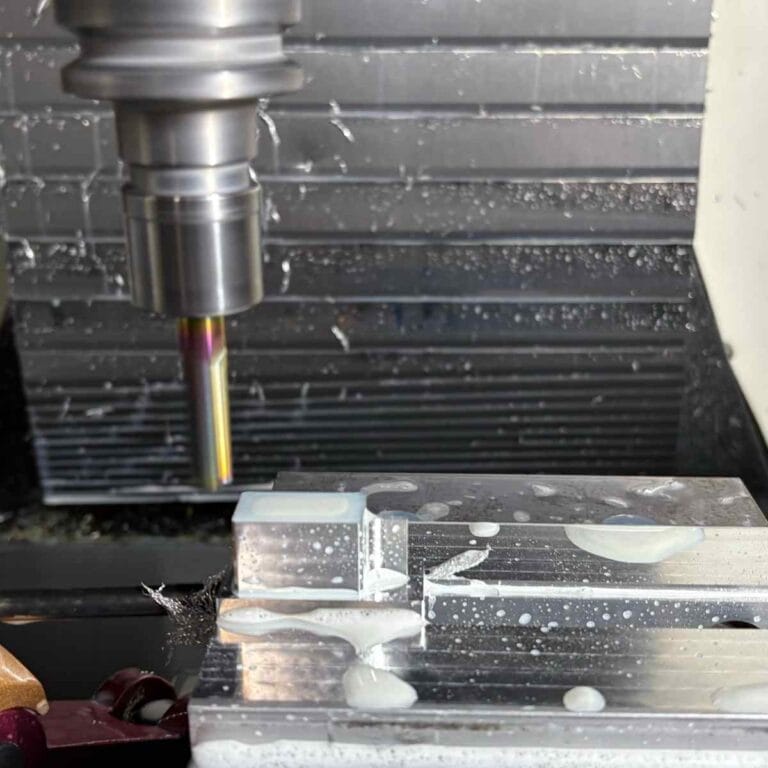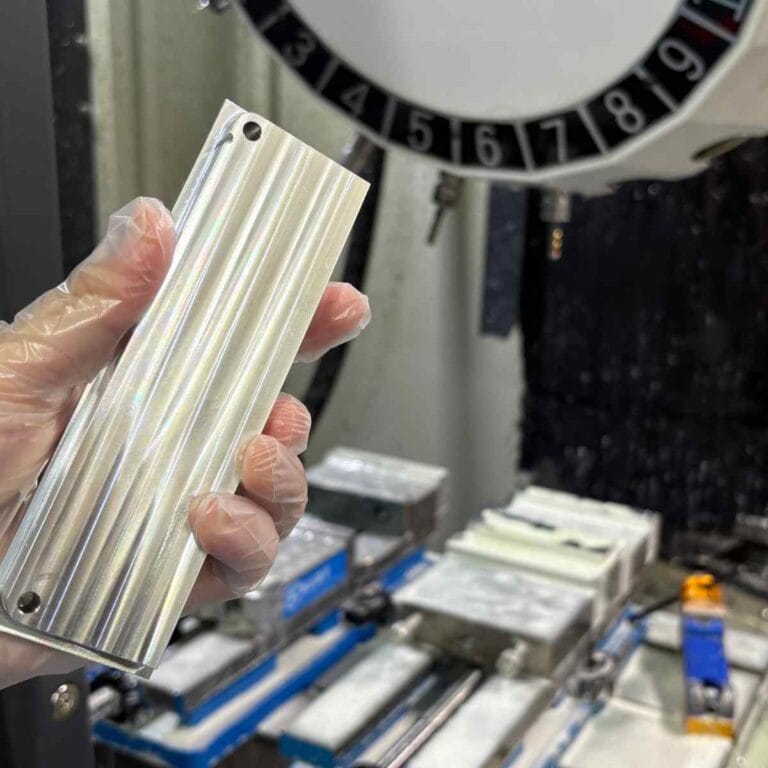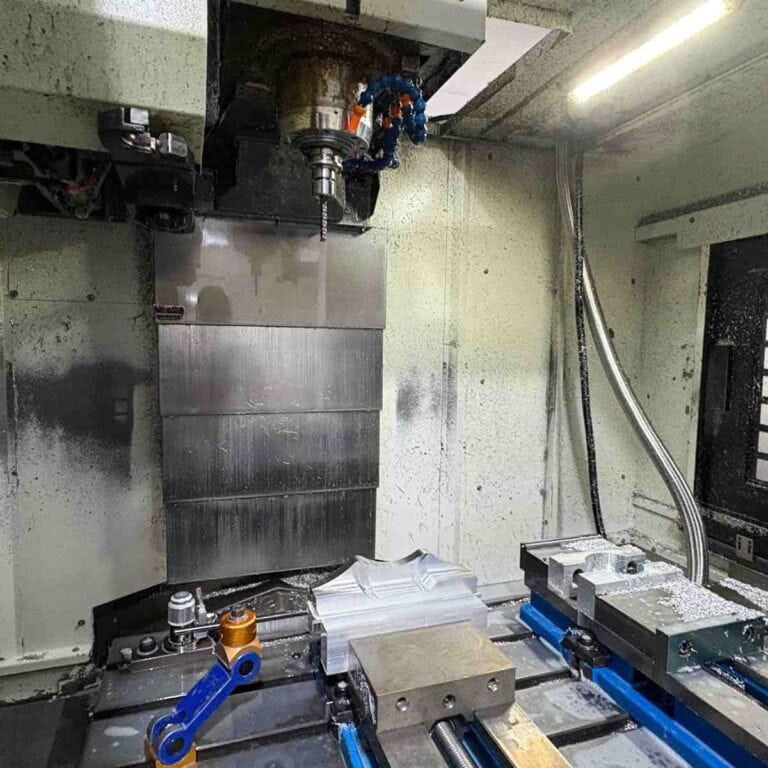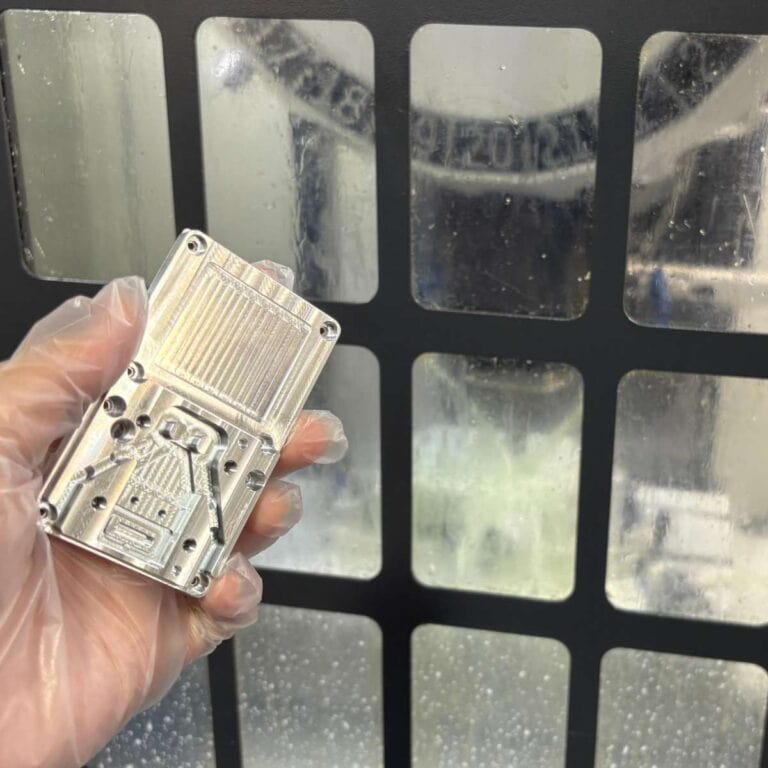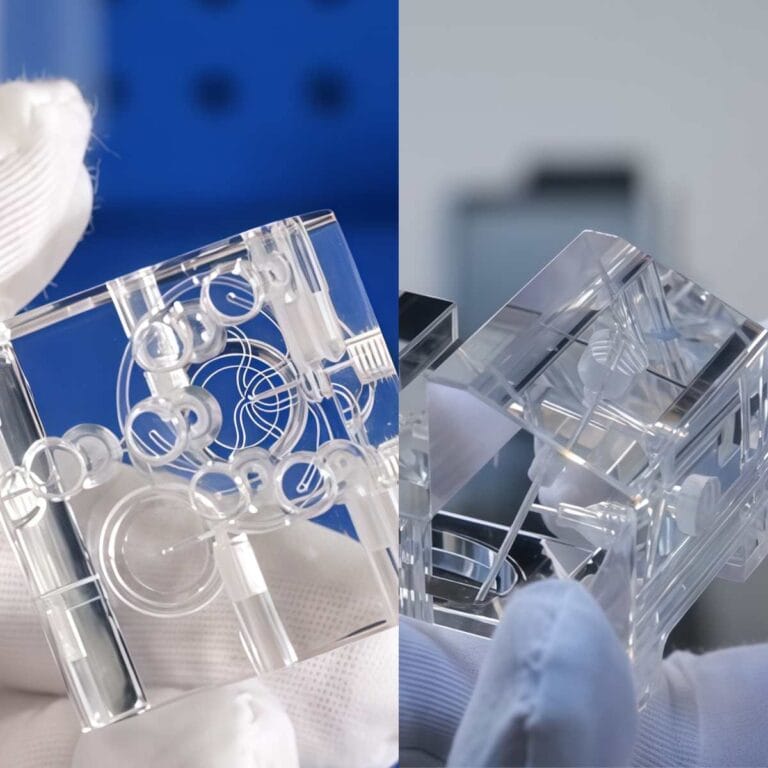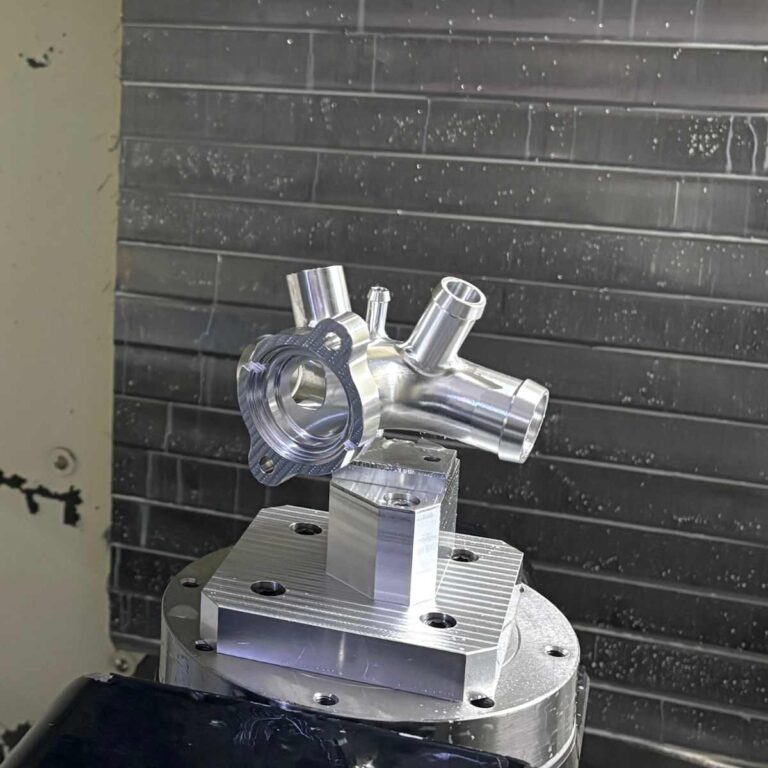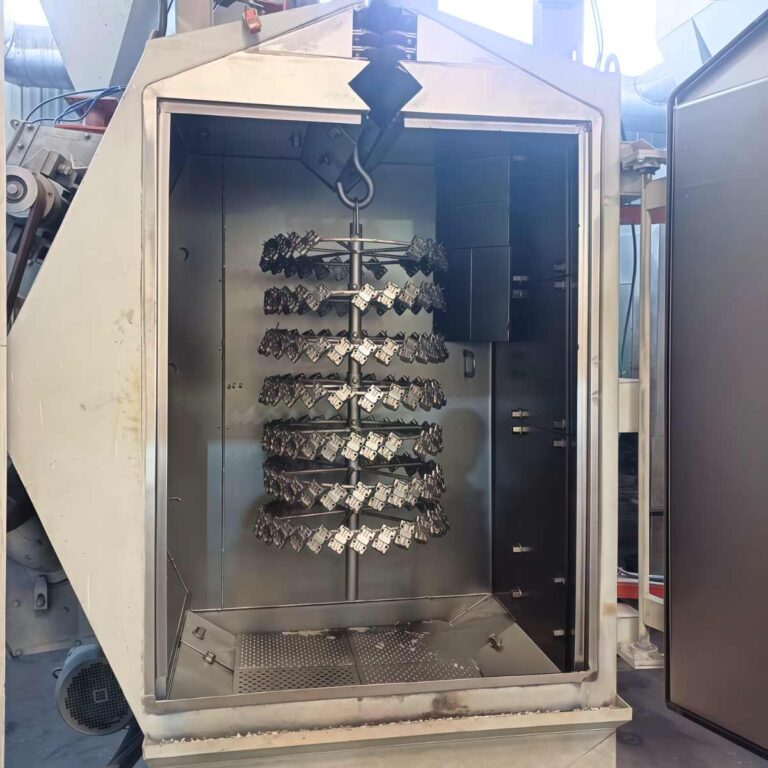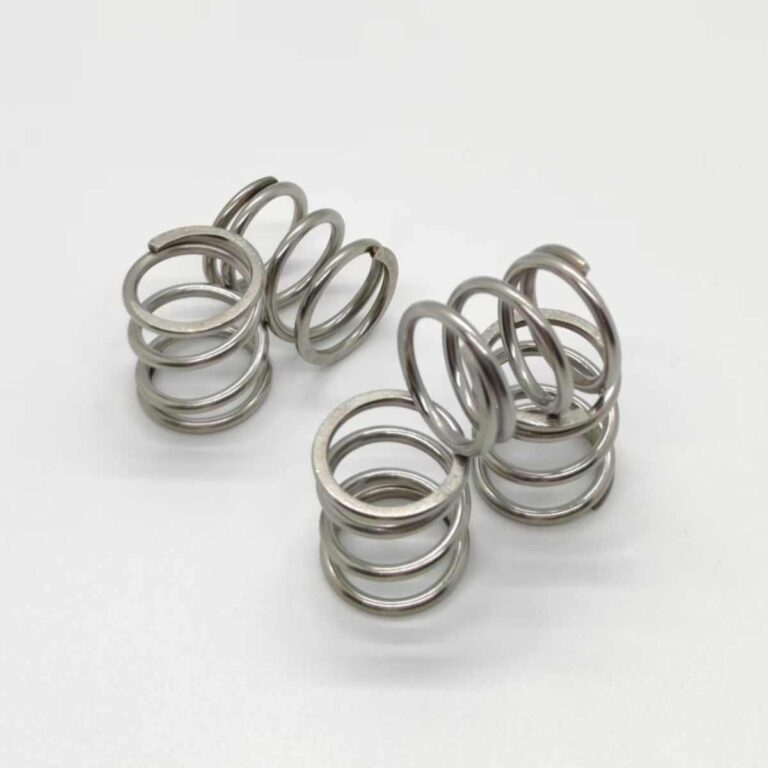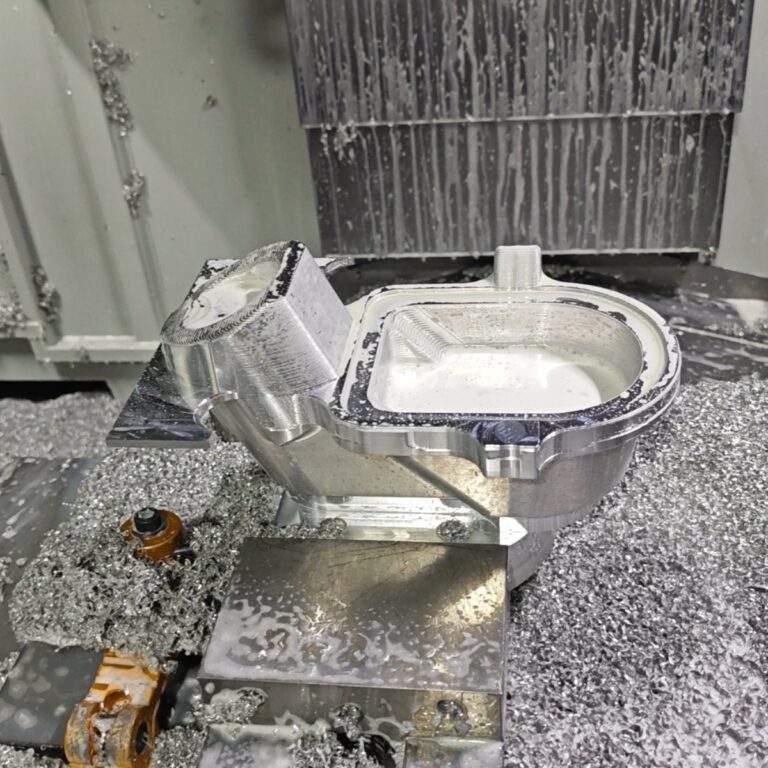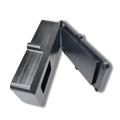Organic glass (PMMA) is widely used in a variety of industries, but processing organic glass requires special attention to operating skills to ensure accuracy and surface quality. This article will take you through every key step of CNC plexiglass processing, from tool selection to cutting technology, to ensure that you master all the key points before cutting.
What Is Plexiglas(PMMA)
PMMA (polymethyl methacrylate) is a transparent plastic that is often used as a substitute for glass. Compared with glass, PMMA has lighter weight, stronger impact resistance and higher processing flexibility, so it is widely used in many industries, such as construction, automobiles, medical and advertising. In my experience, PMMA is not only similar to glass in transparency, but also has many advantages over glass, such as better UV resistance and easier processing, making it an ideal material choice.
Characteristics Of Organic Glass
High Transparency : The transparency of organic glass is close to that of glass, and even exceeds that of glass in some cases, with a light transmittance of up to 92%. Therefore, it is widely used in fields that require high light transmittance, such as display windows, lamps and transparent protective covers.
Strong Impact Resistance : PMMA’s impact strength is 10 to 24 times that of glass, so it performs better in terms of impact resistance and crack resistance, and is often used in situations where durable and safe protection is required.
Easy Processing : PMMA is easier to process than glass. It can be easily cut, milled and formed using CNC machine tools, laser cutting, etc. to meet various complex design requirements.
UV Resistance : PMMA exhibits excellent UV resistance when used in outdoor environments and can be exposed to sunlight for a long time without losing transparency or changing color, which makes it an ideal material for the construction and advertising industries.
Application Areas And Advantages
Lightness : Compared with glass, PMMA is about 50% lighter and is suitable for applications requiring lightweight materials, such as car windows, aircraft windows, etc.
Long-Term Durability : With good weather resistance and corrosion resistance, it is suitable for long-term outdoor use, such as billboards, building facades and sun rooms.
In summary, PMMA has become an indispensable material in modern engineering and design due to its high transparency, strong impact resistance and good processing performance.
How To CNC Process Plexiglas
Organic glass (PMMA) is a common transparent plastic that has been widely used in various industries due to its good transparency, impact resistance and easy processing. When CNC machining organic glass, special attention should be paid to the parameter settings in many aspects to ensure high-precision and high-quality cutting results. By reasonably selecting parameters such as tool, feed speed, spindle speed, etc., surface damage, tool overheating and other problems can be avoided, thereby improving processing efficiency and finished product quality.
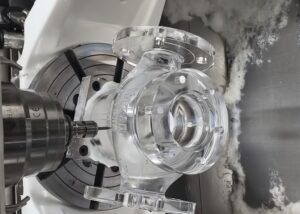
Next, I will introduce the key steps of CNC processing of plexiglass in detail :
Step 1: Fix The Workpiece
In CNC machining, it is crucial to ensure that the workpiece is stably fixed. If the workpiece is not firmly fixed, it may move during the machining process, resulting in reduced cutting accuracy. Common fixing methods include using special fixtures or suction cups to prevent the workpiece from moving during the machining process and maintain machining accuracy.
Step 2: Choose A Tool
It is very important to choose the right tool for processing plexiglass. Carbide milling cutters and two-edge milling cutters are common choices for processing plexiglass. They can effectively reduce surface damage and extend tool life. For thinner plexiglass, using a small diameter tool can ensure a finer cutting effect , while thicker plexiglass requires a larger diameter tool to improve processing efficiency.
Step 3: Feed Speed
Feed speed is an important parameter to ensure smooth cutting. If the feed speed is too fast, it is easy to cause melting and adhesion on the cutting surface . If it is too slow, it will cause the tool to overheat and increase the processing time. For most organic glasses, the recommended feed speed range is 1000-1500mm/min. The specific speed should be adjusted according to the tool, material thickness and spindle speed to achieve the best cutting effect.
Step 4: Spindle Speed
The choice of spindle speed directly affects the cutting effect. A higher spindle speed can help form continuous chips, reduce cutting resistance, and improve processing efficiency. Generally speaking, the spindle speed should be set between 12,000 and 18,000 RPM. For thinner plexiglass, using a higher speed can improve cutting efficiency, while for thicker plexiglass, the speed can be appropriately reduced to avoid overheating and damage.
Step 5: Cutting Depth
The cutting depth should be avoided to be too large. Cutting too deep at one time will increase the burden on the tool, causing tool overheating or workpiece deformation. It is usually recommended to control the cutting depth between 1-2mm each time and make multiple shallow cuts to ensure surface quality. For thicker workpieces, using the layered cutting method can improve the stability and effect of processing.
Step 6: Bevel Cut
Bevel cutting is an effective way to improve cutting results, especially for processing thicker plexiglass. By gradually inserting the tool deeper into the workpiece instead of cutting directly vertically, the tool load can be reduced, avoiding surface damage or workpiece fragmentation caused by excessive cutting force. Using bevel cutting can distribute cutting force more evenly, improve processing efficiency, and extend tool life.
Through reasonable parameter settings and techniques, CNC processing of organic glass can improve production efficiency while ensuring processing accuracy. Each step needs to be adjusted according to specific processing requirements to ensure cutting quality and surface effect. This can not only help reduce problems in processing, but also extend the service life of tools and equipment.
How To Process Organic Glass With CNC
When CNC machining PMMA, we usually choose different processing methods to meet various processing requirements. PMMA is widely used in advertising, construction, automobile, medical and electronics industries due to its high transparency, impact resistance and good processing performance. Whether it is a complex part that requires precision cutting or a simple round part, CNC machining can provide an ideal solution. In order to ensure machining accuracy and surface quality, we need to choose the appropriate processing method according to different process requirements.
Next, I will introduce several common CNC processing methods for plexiglass in detail, and analyze the advantages and applicable scenarios of each method :
CNC Milling
CNC milling is one of the most commonly used technologies for processing cnc plexiglass. Milling can accurately produce complex geometric shapes and parts by cutting along different directions of the workpiece with a milling cutter. CNC plexiglass milling is not only suitable for plane cutting, but also for curved and inclined surface processing, with high flexibility. Especially when processing parts that require fine contours, CNC milling plexiglass can provide high precision of ±0.05mm, which is suitable for occasions that require high surface finish and meticulous processing.
For example, when processing complex parts such as advertising signs and lamp housings, CNC plexiglass milling can ensure that the product has precise dimensions and smooth surfaces. By adjusting the feed rate and speed of the tool, it is possible to effectively avoid overheating or chip sticking, thereby improving the processing quality and extending the tool life. CNC milling plexiglass is suitable for large-scale production, so it is also an ideal choice for processing complex parts and large quantities of similar products.
CNC Turning
CNC turning is a technology used to process round workpieces, especially suitable for processing tubular or cylindrical parts. During the turning process, the workpiece is fixed on a rotating spindle and the tool is cut along the outer surface or inner hole of the workpiece. The accuracy of the turning operation can usually reach ±0.01mm, which is suitable for some parts with symmetrical shapes. Especially for parts with precise outer diameter and inner hole size, CNC turning can provide very high accuracy when machining cnc plexiglass.
For some workpieces with larger diameters, CNC turning can also maintain high processing efficiency and stability. For example, in the manufacture of automotive parts, pipe fittings, and even cnc plexiglass parts, CNC turning can complete processing tasks efficiently and accurately. Since the turning operation itself is relatively simple, it is usually also suitable for some more standardized processing requirements, such as those needed in cnc plexiglass production for precise cylindrical components. With CNC turning, achieving the necessary specifications for cnc plexiglass products is not only possible but also efficient.
Laser Engraving
Laser engraving is a technology suitable for surface detail processing, especially for parts that require fine surface patterns or text. During the laser engraving process, the laser beam melts and evaporates the surface of the organic glass through high temperature, thus forming the required detailed pattern. The accuracy of laser engraving can usually reach ±0.001mm, making it an ideal choice for processing small graphics, text, symbols, and other precise surface details on cnc plexiglass.
A significant advantage of laser engraving is its non-contact processing, which avoids the friction and surface damage that may be caused by the contact between the tool and the workpiece. This makes laser engraving particularly suitable for processing parts with high surface accuracy requirements, such as the shell of medical equipment, graphic designs on advertising signs, and decorative elements on cnc plexiglass products. In addition, laser engraving can also perform deep engraving, create different textures and patterns, and has a wide range of applications, especially in the production of cnc plexiglass with intricate surface designs.
CNC Drilling
CNC drilling is suitable for drilling operations in cnc plexiglass and is often used to manufacture parts with aperture requirements. When drilling cnc plexiglass, it is important to select the right drill bit and the appropriate speed to ensure a smooth cutting process and avoid melting or cracking of the material due to overheating. The accuracy of the drilling operation can usually reach ±0.01mm, which is suitable for drilling holes or making other channels in plexiglass sheets. The drilling process can be combined with other CNC plexiglass machining operations, such as milling or turning, to complete more complex geometries. By using the correct settings, CNC drilling on plexiglass can achieve high precision and excellent surface quality.
CNC Grinding
CNC grinding technology is suitable for surface treatment of organic glass, which can effectively remove surface unevenness and obtain high-finish processing effect. Through the high-speed rotating grinding head, the surface of the workpiece is finely cut. Grinding can remove burrs, scratches and other defects on the surface of organic glass, making the surface of the product smoother and flatter. The grinding accuracy can usually reach **±0.002mm**, so it is often used for parts that require higher surface quality, such as optical lenses, display screens, etc.
CNC EDM
CNC electrical discharge machining (EDM) is a special machining technology suitable for hard or complex-shaped plexiglass parts. EDM uses the discharge between the electrode and the workpiece to accurately cut plexiglass. This method can be applied to complex holes or fine parts that are difficult to machine using conventional methods. EDM offers the ability to create intricate features such as thin walls, small holes, and fine contours in CNC plexiglass components. Due to its high precision, EDM is often used in the manufacture of aerospace, medical equipment, and high-precision parts, with an accuracy of ±0.002mm. When machining CNC plexiglass, EDM allows for the production of parts with highly intricate geometries, making it a go-to method for projects requiring advanced detail.
Furthermore, CNC plexiglass components manufactured using EDM are ideal for industries that demand both precision and high quality. For instance, in aerospace, medical devices, and electronics, plexiglass parts often need to meet strict tolerances, and EDM’s ability to achieve ±0.002mm accuracy makes it a valuable choice. One of the key advantages of EDM in CNC plexiglass machining is that it doesn’t apply mechanical stress to the workpiece, preventing deformation and ensuring that even fragile plexiglass parts maintain their structural integrity. This makes EDM a crucial tool when dealing with complex plexiglass geometries or parts with tight tolerance requirements.
Waterjet Cutting
Waterjet cutting is a non-contact cutting method that uses high-pressure water flow mixed with abrasive materials for cutting. This technique is especially useful for cutting thicker organic glass or parts that require complex shapes. CNC plexiglass is one of the ideal materials for waterjet cutting, as it can be precisely cut without any heat influence, thus avoiding thermal deformation or melting that could occur with other methods. Waterjet cutting offers excellent precision, usually achieving ±0.1mm accuracy, and will not cause adverse effects on the material surface. This makes it an excellent choice for creating intricate parts that require exact shapes, such as custom designs in plexiglass applications.
In the context of CNC plexiglass machining, waterjet cutting allows for high flexibility, making it perfect for applications where traditional cutting methods may struggle. For example, plexiglass used in architectural features, signage, or automotive components often requires clean cuts with intricate shapes. Waterjet cutting ensures that the surface quality is preserved, preventing issues such as cracking or edge chipping, which may occur with other cutting technologies. Therefore, CNC plexiglass components produced via waterjet cutting are ideal for industries that demand both accuracy and high-quality finishes, including automotive, aerospace, and interior design applications.
Laser Cutting
In addition to laser engraving, laser cutting is also a common method for processing plexiglass. Laser cutting can provide high precision and smooth cutting edges, and is particularly suitable for fine cutting on thinner plexiglass. Laser cutting has high cutting speed and accuracy, and is suitable for mass production. It can also handle a variety of complex geometric shapes, and is particularly suitable for making parts with irregular graphics. The accuracy of laser cutting can usually reach **±0.01mm**.
Whether it is CNC milling, turning or laser engraving, CNC processing technology can provide high-precision and high-efficiency processing solutions according to the different needs of the workpiece. Each processing method has its unique advantages and applicable scenarios. For example, CNC milling is suitable for complex shapes and fine parts processing, CNC turning is suitable for rapid processing of symmetrical parts, and laser engraving can achieve high-precision surface detail processing. Understanding these operating methods can help you choose the most appropriate processing method when processing plexiglass, ensure the accuracy and surface quality of the final product, and improve production efficiency.
What Surface Treatments Does Organic Glass Have
Surface treatment of organic glass (PMMA) is a key step to ensure the appearance and performance of the final product. For example, standard treatment, pearl blasting and customized polishing. Depending on the processing requirements and use environment, we can choose different surface treatment methods to make the appearance of organic glass more in line with the design requirements and improve its functionality.
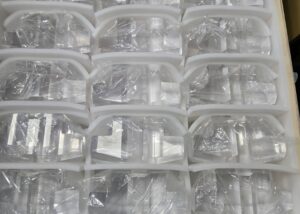
The following are several common methods for surface treatment of plexiglass, each of which has its own unique effects and application scenarios :
Standard Processing
Definition: Standard finish is the surface after the basic cutting process, usually without additional surface processing or decoration. This finish is suitable for most common applications, especially when dealing with CNC plexiglass parts that don’t require intricate surface detailing. The result is a clean and smooth surface ideal for parts where functional performance is the priority over aesthetics. For CNC plexiglass applications, standard finishes ensure that the product can still provide sufficient optical clarity and smoothness, making it a reliable option for various everyday uses.
Applicable Scenarios: Standard finish is commonly used for creating CNC plexiglass display racks, simple advertising signs, and electronic product housings. These parts typically don’t demand high-end surface treatments but still need to maintain transparency and smoothness. Whether for CNC plexiglass signage in retail environments or transparent housings for electronic devices, the standard finish serves the purpose well. Despite its simplicity, the finish provides the necessary clarity and visual appeal for such applications. It is often the go-to solution for high-volume production runs in industries that require basic CNC plexiglass components that meet functional requirements at a cost-effective price point.
Pearlescent Sandblasting
Definition: Pearl blasting is the process of using sandblasting equipment to blow tiny particles onto the surface of CNC plexiglass, creating a uniform matte effect. This technique enhances the appearance of CNC plexiglass by increasing its surface roughness and giving it a slightly frosted look. By applying this method to CNC plexiglass parts, it is possible to achieve a consistent, non-reflective finish that is ideal for products needing a soft, muted appearance. This surface treatment is particularly useful for parts exposed to high light sources, as it helps diffuse light and reduce glare, while still maintaining the transparency of CNC plexiglass.
Applicable Scenarios: Pearl blasting is especially suitable for situations where part of the content needs to be blocked or when there is a need to enhance the surface decoration of CNC plexiglass. This method is commonly applied in environments like billboards, light boxes, and automotive parts. For example, CNC plexiglass used in signage or advertising displays benefits from pearl blasting, as it reduces glare while still showcasing the message or logo clearly. In automotive applications, the matte finish achieved through sandblasting can provide a stylish yet functional appearance, and help with light diffusion in interior panels. By preventing excessive light reflection, pearl blasting ensures CNC plexiglass parts maintain their aesthetic while being easy to read or view.
Custom Polishing
Definition : Custom polishing is a process of fine polishing that makes the surface of plexiglass as smooth as a mirror, showing a mirror effect. This method usually requires multiple polishing to ensure that the surface is scratch-free and has a very high gloss.
Applicable Scenarios : Commonly used in high-end decorations, optical lenses, display screen protection covers and other applications that require extremely high finish. Polished organic glass can provide high transparency and excellent visual effects.
Advantages : Can significantly improve the appearance quality of the product, provide extreme transparency and smooth surface, making the finished product more beautiful and high-end
Depending on the different usage needs and processing requirements, the methods of surface treatment of organic glass are also different. From the basic standard cutting surface to the more sophisticated pearlescent sandblasting and customized polishing, each treatment method can give the finished product a unique appearance and functionality. Choosing the right surface treatment technology can not only improve product quality, but also improve the market competitiveness of the product.
Advantages Of Plexiglass
Organic glass (PMMA) is a transparent material widely used in various fields. With its advantages of light weight, impact resistance and high transparency, it has become an indispensable material in modern manufacturing and daily life. Compared with glass, it is easier to process and has stronger impact resistance, and can replace traditional glass materials in many fields.
Next, I will introduce the advantages of plexiglass and its applications in various industries :
| Advantages | Describe |
| Easy to process | Organic glass can be processed into various complex shapes by cutting, milling, drilling, etc. |
| Lightweight and impact-resistant | It is 50% lighter than glass and has high impact resistance, making it suitable for replacing fragile materials. |
| High transparency | It has a transparency close to that of glass, with a light transmittance of up to 92%, and is widely used in places that require high light transmittance. |
| UV resistance | Excellent UV resistance, suitable for long-term exposure to outdoor environments while maintaining unchanged transparency. |
Application Areas Of Plexiglass
Organic glass has been widely used in many industries. Its excellent performance makes it perform well in various complex environments, especially in areas that require lightweight, transparent and durable materials. Whether in the automotive, construction, medical or electronics industries, organic glass plays an important role.
Next, I will give you a detailed introduction to the application of organic glass in various industries :
| Industry | Application Examples |
| Automotive Industry | Used for car windows, dashboards, rearview mirrors and other parts, it is lightweight and impact-resistant. |
| Lighting and electronics | Used to make lamp covers, display screen protectors, lighting housings, etc., providing good transparency and UV resistance. |
| Architecture and decoration | Used for transparent roofs, curtain walls, advertising signs, etc., and suitable for outdoor use due to its transparency and weather resistance. |
| Medical Industry | Used in medical device housings, dialyzer housings, etc., meeting the requirements for cleanliness, transparency and impact resistance. |
FAQs
Can You CNC Plexiglass?
Yes, CNC machines can effectively cut plexiglass, also known as acrylic. CNC milling and routing are the most common methods for cutting plexiglass, allowing for high precision and smooth finishes. With the rich tools and settings, CNC machines can cut plexiglass with a tolerance of ±0.1mm , making them ideal for intricate shapes and detailed designs. It’s crucial to select the correct cutting speed, feed rate, and tooling to avoid material damage and achieve the desired result.
What Speed Do CNC Machines Cut Plexiglass?
When cutting plexiglass with a CNC machine, the recommended spindle speed ranges between 12,000 to 18,000 RPM. This speed range helps ensure that the material is cut efficiently without causing excessive heat buildup, which could result in melting or fraying edges. The optimal feed rate is usually around 1000-1500 mm/min, but it should be adjusted based on the thickness of the material and the type of cut being made to ensure a smooth finish and minimal tool wear.
What Is the Best Method of Cutting Plexiglass?
The best method of cutting plexiglass depends on the complexity and requirements of the project. CNC routing is ideal for precision and intricate shapes, while laser cutting offers excellent results for fine details and smooth edges. For larger or simpler cuts, using a table saw with a fine-toothed blade works well. For straight cuts or small projects, a glass cutter can be used effectively. The method chosen should be based on the specific application, material thickness, and desired finish.
Can You Cut Plexiglass With a Glass Cutter?
Yes, plexiglass can be cut with a glass cutter, but it’s typically suited for straight-line cuts. A glass cutter is effective for scoring the surface of the plexiglass, after which it can be snapped cleanly. This method is most effective for thinner sheets, typically less than 6mm thick. For more complex shapes or thicker sheets, CNC cutting or laser cutting methods are recommended, as they offer greater precision and smoother edges.
How to Smooth the Edges of Plexiglass?
To smooth the edges of plexiglass, several methods can be used, depending on the desired finish. A flame-polishing tool is one of the best options for achieving a glossy, smooth edge, especially for clear plexiglass. Sanding with progressively finer sandpaper (starting with 400-grit and moving to 2000-grit) is another common method for smoothing edges. After sanding, polishing with a soft cloth and acrylic polish can help achieve a high-quality finish, giving the edge a clean, professional look.
How Hard Is It to Break Plexiglass?
Plexiglass is known for its toughness and impact resistance, making it significantly harder to break than glass. However, while it’s much stronger than glass, it is still prone to cracking or breaking under excessive pressure, especially when subjected to sharp impacts. The material’s strength is measured by its impact resistance, which is approximately 10-24 times higher than glass, depending on the grade of plexiglass. Despite its strength, proper handling is necessary to avoid fractures.
Conclusion
As a transparent and powerful material, organic glass has been widely used in many industries due to its advantages in processability, impact resistance, transparency and weather resistance. It not only provides us with higher design freedom and processing flexibility, but also improves the durability and aesthetics of products in various applications. Through the correct material selection and processing methods, we can give full play to the advantages of organic glass and meet the needs of different fields.

